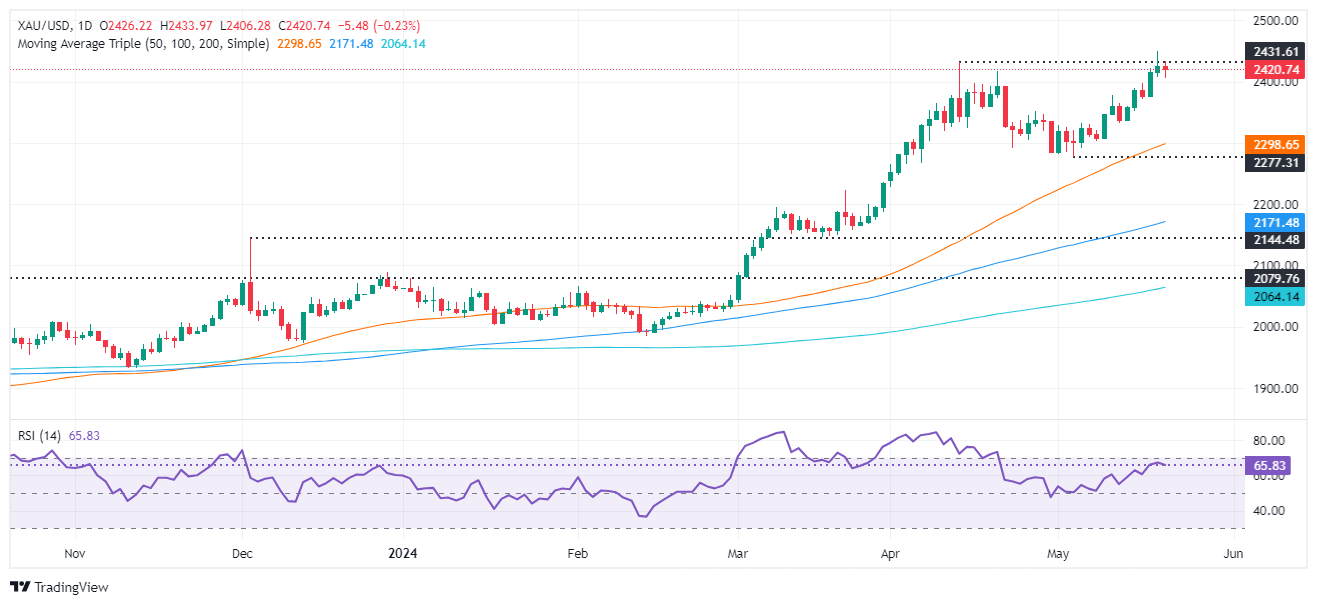- Gold falls below $2,430, losing 0.28% after reaching an all-time high of $2,450.
- US Treasury yields fall and the 10-year TIPS yield falls three basis points to 2.081%.
- Hedge funds increase bullish bets on Gold futures to three-week highs, limiting XAU/USD losses.
The price of Gold fell during the North American session on Tuesday after reaching an all-time high of $2,450. However, it retreated below the April 12 high of $2,431, as the dollar regains some ground. The limited economic agenda keeps operators waiting for the words of the Fed, which remained cautious when signaling the start of rate cuts.
XAU/USD is trading at $2,418, losing 0.28%, after reaching a high of $2,433. Wall Street indices continue to rise, a headwind for the gold metal's safe haven status. Although it is sought as a “hedge” against inflation, investors seem reluctant to give up the profits of the US stock market.
Furthermore, Federal Reserve (Fed) officials continued to cross the wires and adhere to their stance of maintaining interest rates until the disinflationary process evolves.
Despite this, US Treasury yields fell. The yield on US benchmark 10-year bonds fell three and a half basis points to 4.41%, while the 10-year yield on Treasury Inflation Protected Securities (TIPS), whose correlation with gold prices Inversely, it fell three basis points, to 2,081%.
Data from the Commodities Futures Trading Commission (CFTC) showed that hedge funds increased bullish bets on gold futures to a three-week high in the week ending May 14.
Minutes from the latest Fed meeting were released on Wednesday. On Thursday, initial jobless claims are expected to show the labor market is cooling, along with the Chicago Fed's national activity index.
Daily Market Moves Summary: Gold Price Falls Despite Falling US Yields Following Fed Comments
- The price of Gold falls due to the fall in US Treasury yields and the weakening of the US Dollar. The US Dollar Index (DXY), which tracks the USD against a basket of six other currencies, is virtually unchanged at 104.64, capping XAU/USD prices.
- Last week's inflation data showed that core prices are easing. This revived traders' expectations that the US central bank would resume its easing policy. They should be cautious, however, as Fed officials opposed a single reading that indicates inflation is moderating.
- Atlanta Fed President Raphael Bostic stated that he is in no rush to reduce interest rates and prefers to keep them stable, emphasizing that the Fed's top priority remains tackling inflation.
- Fed Governor Christopher Waller acknowledged that the April CPI showed progress, but mentioned that he needs to see several months of favorable inflation data before he can support a rate cut. For his part, Michael Barr, vice president for oversight, said: “We still have to finish the work on inflation.”
- On Monday, Vice President Philip Jefferson said it is too easy to know when disinflation will resume, while calling the official interest rate restrictive. Cleveland Fed President Loretta Mester stated that inflation risks are tilted to the upside.
- Chicago Board of Trade data shows investors expect 35 basis points of Fed easing by the end of the year.
Technical Analysis: Gold Price Falls Below $2,450 and Bears Target $2,400
Gold's uptrend remains intact, but a daily close below the May 20 low of $2,407 could pave the way for a pullback. This development could form a “dark cloud cover”, a two-candle chart pattern that implies that XAU/USD may make another leg lower before extending its rally.
Momentum is on the back of the buyers as evidenced by the RSI in bullish territory. However, the RSI is pointing downwards, and once it surpasses the midline of 50, further declines will have to be expected.
To the upside, the first resistance for XAU/USD would be the April 12 high at $2,431, followed by the all-time high at $2,450.
Conversely, if XAU/USD pulls back below $2,400, it could expose the May 13 low at $2,332, followed by the May 8 low at $2,303. Once these levels are broken, the 50-day SMA at $2,284 will be the next target.
The Fed FAQs
The monetary policy of the United States is directed by the Federal Reserve (Fed). The Fed has two mandates: achieving price stability and promoting full employment. Your main tool to achieve these objectives is to adjust interest rates. When prices rise too quickly and inflation exceeds the Federal Reserve's 2% target, it raises interest rates, raising borrowing costs throughout the economy. This translates into a strengthening of the US Dollar (USD), as it makes the United States a more attractive place for international investors to place their money. When inflation falls below 2% or the unemployment rate is too high, the Federal Reserve can lower interest rates to encourage borrowing, which weighs on the greenback.
The Federal Reserve (Fed) holds eight meetings a year, in which the Federal Open Market Committee (FOMC) evaluates the economic situation and makes monetary policy decisions. The FOMC is made up of twelve Federal Reserve officials: the seven members of the Board of Governors, the president of the Federal Reserve Bank of New York, and four of the eleven presidents of the regional Reserve banks, who serve for one year on a rotating basis.
In extreme situations, the Federal Reserve can resort to a policy called Quantitative Easing (QE). QE is the process by which the Fed substantially increases the flow of credit into a clogged financial system. It is a non-standard policy measure used during crises or when inflation is extremely low. It was the Fed's weapon of choice during the Great Financial Crisis of 2008. It involves the Fed printing more dollars and using them to buy high-quality bonds from financial institutions. QE usually weakens the US dollar.
Quantitative tightening (QT) is the reverse process of QE, whereby the Federal Reserve stops buying bonds from financial institutions and does not reinvest the capital of the maturing bonds it has in its portfolio to buy new bonds. It is usually positive for the value of the US Dollar.
Source: Fx Street
I am Joshua Winder, a senior-level journalist and editor at World Stock Market. I specialize in covering news related to the stock market and economic trends. With more than 8 years of experience in this field, I have become an expert in financial reporting.








